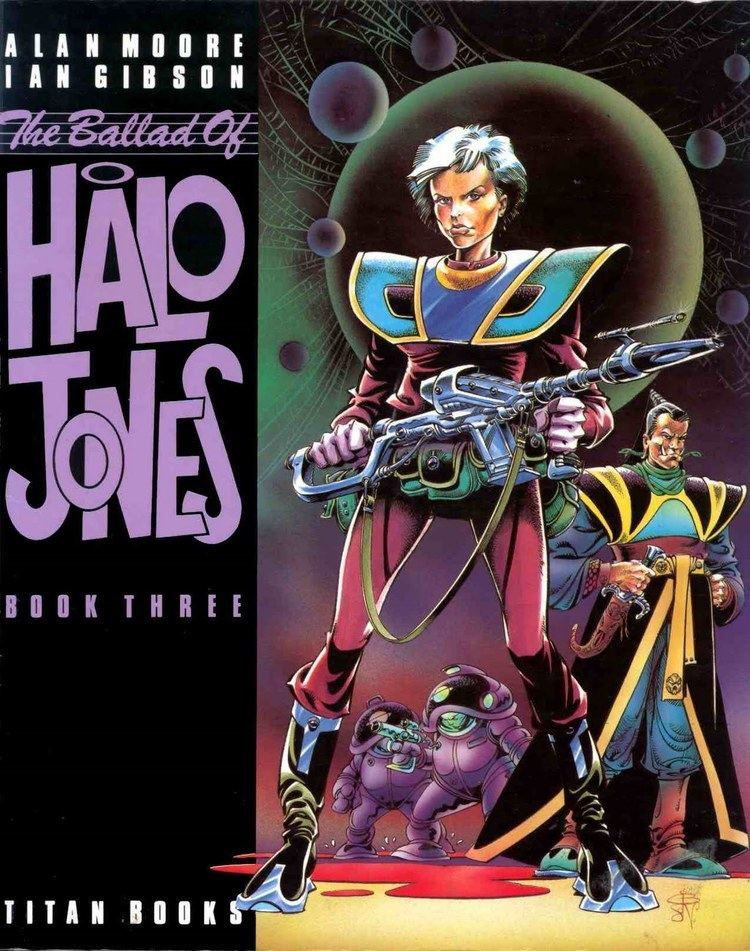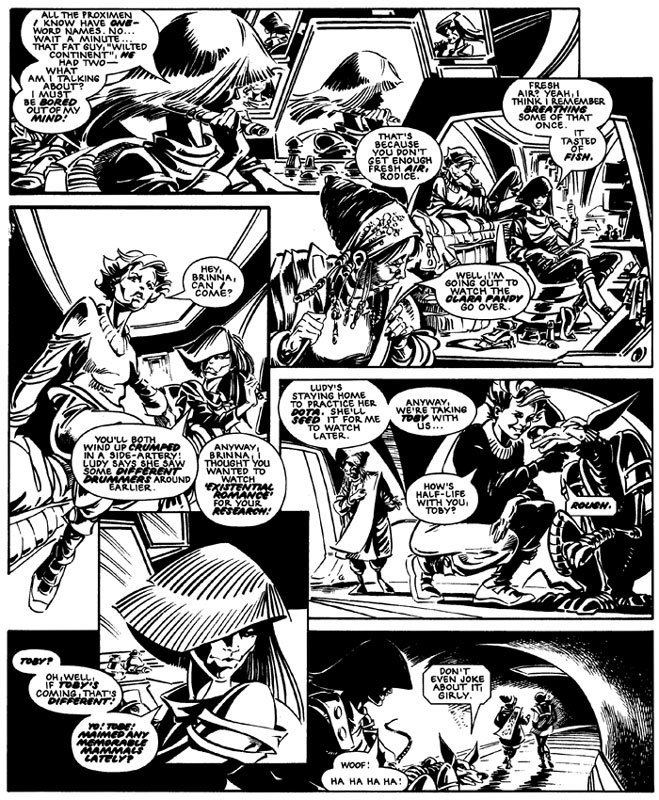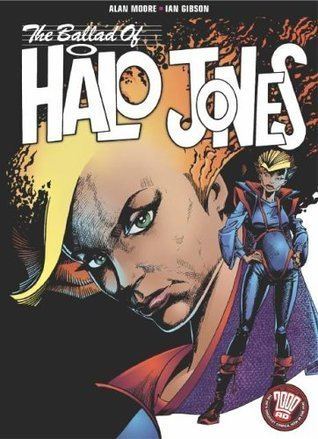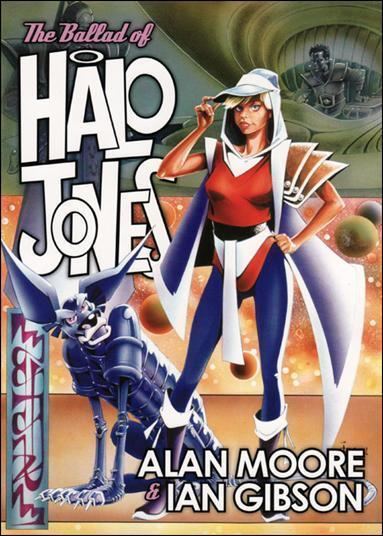 | ||
Similar Strontium Dog, Rogue Trooper, Caballistics - Inc, Charley's War, The VCs | ||
The 2000 ad abc 13 the ballad of halo jones
The Ballad of Halo Jones is a science fiction comic strip written by Alan Moore and drawn by Ian Gibson, with lettering by Steve Potter (Books 1 & 2) and Richard Starkings (Book 3).
Contents
- The 2000 ad abc 13 the ballad of halo jones
- The ballad of halo jones comic book review
- Synopsis
- Locations and characters
- Development
- Influences on the series
- Creator cameos
- Book 4 and possible continuations
- Other appearances
- Reprinting
- US Quality Comics
- Cultural allusions in Halo Jones
- In popular culture
- Merchandiseadaptations
- References

Halo Jones first appeared July 1984 in five-page instalments in the pages of the weekly British comic 2000 AD and is regarded as one of the high points of 2000 AD. The eponymous heroine is a highly sympathetic 50th-century everywoman, and the tone of the strip runs from the comic to the poignant. The three "books" span more than ten years of her life, and also serve as a tour of the well-realized futuristic universe which Moore and Gibson created. Originally, Halo Jones was planned to run to nine books, chronicling Halo's life from adolescence through old age. However, the series was discontinued after three books due to a dispute between Moore and Fleetway, the magazine's publishers, over the intellectual property rights of the characters Moore and Gibson had co-created.

The ballad of halo jones comic book review
Synopsis
The three books in the series are:



Locations and characters

Other places she had visited or spent time in included Proxima IV, Vescue, Sirius, Skinner's World, and Popotoplec. Although it is mentioned that she met the famous historical figure Sally Quasa, this meeting does not take place in the first 3 books.
Development
In his introductions to the three 1986 Titan editions, Moore described its genesis. The story was designed from the outset to avoid the typical 2000 AD story elements: "guns, guys and gore." Moore said that he had "no inclination to unleash yet another 'Tough Bitch With A Disintegrator And An Extra Y-Chromosome' upon the world". The idea to base the strip around an ordinary, unremarkable woman, typical of the society she lived in, was also very different for 2000 AD.
Gibson and Moore designed the world that Halo would live in with as much detail as possible. Book One may have been mildly criticised for dropping readers into a future world with no explanation of its societal structure, culture, language etc., but on closer inspection the book was designed to reveal aspects of this carefully constructed world in subtle and clever ways. The creators introduce us to 50th century politics, social problems, diet (vegan), cults, music, futuristic slang, fashion and also an ongoing off-world war that is clearly taking place in the background.
Moore and Gibson's collaboration paid off when the go-ahead for a second series was given. Both men were excited about where the story was heading and Book Two expanded upon what they had created before. They upped the action quotient and also created some shattering emotional scenes. Moore has said that the character of "the Glyph", introduced in Book Two, clinched the book's success (according to his comments in the introduction to the collected edition (Titan Books) in 1986).
Influences on the series
Reviewers have attributed a number of influences from other sources, in particular the influence, on Book 3, of a number of classic anti-war science-fiction stories. These notably include a couple of stories written partly as a response to the gung-ho attitude of Starship Troopers:
Creator cameos
Both Ian Gibson and Alan Moore make a cameo appearance in the series. In Book 3, when Halo first arrives at the Glory Barge on the planet Pwuc (where she meets Toy recruiting soldiers for the Terran army), Gibson and Moore appear as two figures in the crowd – a bearded man holding a pencil and another man holding a paintbrush. Alan Moore can also be seen being rickshawed through the rainy street on the planet Hispus after Halo has signed her release papers.
Book 4 and possible continuations
Since the publication of Book Three in 1986 fans of the series have been speculating on the possibility of Halo returning for further adventures. In his introduction to the Titan reprint of Book Three in 1986 Alan Moore seemed to be leaving an open door for Halo's story to return to the comic:
Whether this really is the last book remains to be seen. While there are currently no plans to continue the series, due to external circumstances and considerations, I think it's fair to say that, were these circumstances to alter, both Ian and myself would be only too pleased to resume The Ballad and continue to relate the history of a character to whom we've both grown very attached over the couple of years that we've worked with her. You know how it is...we've been out with her a couple of times and the chances are that if she's free, one day we might go out with her again. Who knows? Maybe we'll let you come along too.
Moore has had very little to say about Halo's return in the two decades since then. "I'd got plans to have her grow up and eventually end as an old woman," Moore told Mustard magazine in January 2006. "But I got to the point where I'd said to IPC, "Look, you know that you've ripped these characters off from us. If you were to give us the rights back, I would gladly write another three books of Halo Jones. Whereas if you don't I will never write Halo Jones and you won't get any money from the character. And they thought, 'Yeah, let's hang on to the character forever and you never get any rights to it and never write any again.' So that's where it is." A report from a 2004 BBC radio interview taping recalls that when asked to tell the audience about Halo Jones, "Moore smiled fondly as if someone had just reminded him of an ex-girlfriend who he'd never meant to split up with."
In an interview with Pádraig Ó Méalóid for 3:AM Magazine (published March 2011), Alan Moore stated "the next adventure would have probably been when she was a female space pirate with Sally Quasa", "I would have been basically going through all the decades of her life, with her getting older in each one, because I liked the idea, at the time, of having a strip in 2000AD with a seventy or eighty year old woman as the title character", "it would have ended up with Halo Jones upon some planet that is right at the absolute edge of the universe where, beyond that, beyond some sort of spectacular lightshow, there is no space, no time, and it would have ended up with Halo Jones – all the rest of the people on this planetoid because, actually, time is not passing; you could stay there forever, potentially – and what would have happened is that Halo Jones, after spending some time with the rest of the immortals, would have tottered across the landing field, got into her spacecraft, and flown into the psychedelic lightshow, to finally get out."
In a recent interview with Gavin Hanly on the 2000AD Review site, Ian Gibson is asked about people's ongoing interest in the series and whether there was ever any intention to do a fourth series:
I'm very happy that Halo had such an effect. After all, that's why I asked Alan to write a girl's story. I thought it would make a difference... Alan and I had planned out Halo's future to a conclusion, but the series was interrupted by the dispute over copyright allocation, where Alan wanted to have all writers, like John Wagner et al., get their fair dues after streaming out a steady supply of genius for so many years. That's what I heard anyway – but I can't speak with authority as I wasn't involved in the negotiations. I have tried to contact Alan over the years, but with no luck. I have my own ideas of what could happen in the next couple of books that I'd have liked the chance to run past Alan, but I think he's discarded the story from his future..." In another interview on the Ximoc site Gibson reiterates his desire to keep the series going. When asked about his "dream project" he says: "I'm also sure that many of Halo's fans would like me to do some more books to continue the series. Just a shame Alan doesn't want to be involved (as far as I know?)
Other appearances
The last occasion that Moore and Gibson collaborated on a Halo piece was for the 500th edition of 2000 AD in December 1986. A portrait of Halo is featured on this special issue's glossy cover. Inside many 2000 AD artists had fun with their own creations. In the strip "Thargshead Revisited" the editor of the comic (the alien Tharg) takes a journey through his own head and encounters many characters from 2000AD's past. The page drawn by Ian Gibson features Halo, Rodice and Toy involved in a game of strip poker with Sam Slade (with the head of Luiz Cannibal on a plate on the table). This was the last time that Moore wrote dialogue for these characters.
Prog 2000 featured Halo beating Hap Hazzard and Finn before getting blown away by the Missionary Man in that issue's character Deathmatch.
"Helter Skelter", a Judge Dredd story written by Garth Ennis (12 episodes Progs 1250–1261) features cameos from a myriad of previous 2000AD characters including Halo Jones in episodes 6 & 7. Artwork by Carlos Ezquerra and Henry Flint.
Jones has since appeared on one page of the 20th anniversary strip 'A Night 2 Remember' (Prog 1280), written by Robbie Morrison and illustrated by Gibson.
Reprinting
In December 2000 a special 2000AD issue (titled 'Prog 2001') was released featuring another full colour portrait of Halo. Titan were planning a reissue of the Complete Ballad of Halo Jones in July 2001 and this portrait was used as the cover art. The first collected edition had been published by Titan in September 1991. This time the introduction to the book was written by Ian Gibson. The release of this volume garnered positive reviews and renewed many people's interest in Halo Jones. 2000AD hyped up the release on its site: "Alan Moore's hugely acclaimed saga of one woman's quest for reason in a galaxy gone mad. Out of print now for nearly a decade, fans have been clamouring for this collection anew, especially with the success of Moore's ABC line. This classic tale, lovingly rendered by artist Ian Gibson, is now available again in its epic entirety".
The back cover of the book similarly heralded the return of a comic legend: "Meet Halo Jones. She's going out...and out...and out! Escaping the Hoop, Manhattan Island's land of mindless leisure, is just the first step in a cosmic adventure that will take Halo to the far ends of the galaxy, through war and peace, trial, despair and triumph. You've never met anyone quite like Halo...and you never will again."
"Possibly the first feminist heroine in comics", wrote The Observer of Alan Moore's epic tale of one woman's search for her place in a galaxy out of control. "Originally published in 2000 AD and then collected by Titan Books, this classic tale of future alienation and an individual's struggle remains a timeless testament to the genius of Moore. Beautifully illustrated by artist Ian Gibson, this is the ultimate sci-fi opus. Don't dare miss it!"
US reviewers also welcomed the book's return: "Criminally out of print for the last few years. Halo Jones is one of the finest graphic novels ever created – if you've never given them a go, shame on you – but this is the perfect place to start if men in tights superhero stuff puts you off. Halo Jones has it all – a fantastic storyline, cinematic graphics and characters that knock dead most of the ciphers you find in contemporary fiction."
The Complete Ballad of Halo Jones was voted the third best book of 2001 by the readers of Dreamwatch magazine.
US Quality Comics
A year after her stories had left the pages of 2000 AD, The Ballad of Halo Jones was reprinted in the United States by Quality Comics. Publisher's Bob Keenan and Sal Quartuccio had secured the rights to reissue colourised versions of Judge Dredd, Rogue Trooper, Strontium Dog, Sam Slade and Halo Jones – the cream of 2000AD's catalogue at that time. New covers were commissioned for these comics by artists such as Bill Mayer, Bart Sears and Jim Fern. Eva Brozowski served as the colourist for the covers (her initials can be seen separately to the artist's). To fit the square 2000AD pages to American comic book format, Quality attached a distorting lens to a photocopy machine, elongating and "effectively destroying the art in the process" according to one reviewer. The covers mimic Gibson's original art but arguably never compare favourably, issue No. 7 shows Lux Roth Chop transformed from a young boy to a sinewy adult, another shows a high-heeled soldier version of Halo Jones. These reprints are now quite sought after and are a fixture on eBay and other auction sites. The telephone booth cover of issue No. 1 was used at the time on a mail-order $10 T-shirt by Quality Comics with the slogan "Halo Jones – Your Destiny's calling!" The Quality Comics reprints did however do Halo one major injustice: the very last line of Book Three ("Just out") is obscured by a large "The End" title.
As well as the main story these reprints also include some Gibson work from 2000AD's vaults such as 'The Amazing Maze Dumoir', and 'You Win Some You Lose Some' (the latter two both scripted by A Hebden). Also featured during this run were episodes from 'Anderson Psi Division', 'Ro-busters', 'Sooner Or Later', 'Dash Decent' and Alan Moore's 'Abelard Snazz Misadventures' and his Future Shocks story 'Sunburn'.
Cultural allusions in Halo Jones
Toy Molto: The name alludes to the toy company Molto.
I'll Never Forget What's 'is Name: The episode in which the glyph tells her/his story on the Clara Pandy gets its title from the 1967 movie of the same name starring Oliver Reed and Orson Welles.
Ludwig Wittgenstein (1889–1951). Philosopher. Halo buys Brinna a sitdram called "Wittgenstein has risen from his grave."
Jazz Firpo: A reporter who interviews Luiz Cannibal for Swifty Frisko at the close of Book One. Roberto Firpo was a pioneer in the early part of the 20th century with Tango rhythms.
Terhune: A planet where the army recruiting officer mentions that soldiers can relax at an officers bar. Max 'Lullaby' 'Alibi' Terhune (real name: Robert Max Terhune Sr) 1891–1973 was the star of westerns or "sagebrush adventures".
Myrmidon: Sergeant Myrmidon trains Halo in the art of warfare before dying on Moab. In Greek mythology, the myrmidons were a warlike Thessalian people who were ruled by Achilles and followed him on the expedition against Troy. Another meaning for the word myrmidon is "a faithful follower who carries out orders without question".
Moab: The name Moab is a Biblical name for a land just short of the Promised Land. Moses having fallen from God's grace could glimpse the Promised Land from Moab but could not enter it.
Different Drummers: "If a man does not keep pace with his companions, perhaps it is because he hears a different drummer. Let him step to the music he hears, however measured or far away". (Henry David Thoreau, 1817–1862)
Perelandra: In the prologue to Book 2, Mr Sotgore taunts Dr Brunhauer that he wants to earn enough money from his historical work on Halo Jones to retire to Perelandra. This was the name of the paradisiacal planet Venus in the science fiction trilogy of C. S. Lewis.
A Soldier's Things: The title of Part 6 of Book 3 is a possible reference to the Tom Waits song Soldier's Things, from his 1983 album Swordfishtrombones.
Breakfast in the Ruins: The title of Part 14 of Book 3 is a reference to the Michael Moorcock book Breakfast in the Ruins.
In popular culture
Halo Jones has been mentioned in popular culture:
The UK band Halo James was named after the eponymous character
The debut album Pop Art by 1980s group Transvision Vamp features a track entitled "Hanging out with Halo Jones"
The Shriekback song "Malaria" includes the line "I wanna live with Halo Jones"
Merchandise/adaptations
A stage adaptation of The Ballad of Halo Jones was a surprise hit at the 1987 Edinburgh Festival. In 1988 the Red Theatre Company toured the show around the UK. Cast: Clare Fairley (Halo Jones), Debbie Howard (Rodice), Nicky McRoy (Toy), Andy Veal (Toby), Angela Clifford (Ludy), Dave Barrett (the Glyph).
Another stage adaptation: In 2001, Andrew Ness adapted Book One of the story to the Liverpool stage.
In 2012, a new stage adaptation covering Book One and Book Two of the series was performed as a fringe theatre production in Manchester. Leah Moore attended one of the performances.
Halo Jones T-shirts issued by 2000AD in the 1980s had the slogan "Hoop-life Hero" on them.
Computer game: Programmers Mike Lewis and Carl Cropley developed a Halo Jones game in the 1980s for the Spectrum computer, based around the shopping trip that Halo takes.
